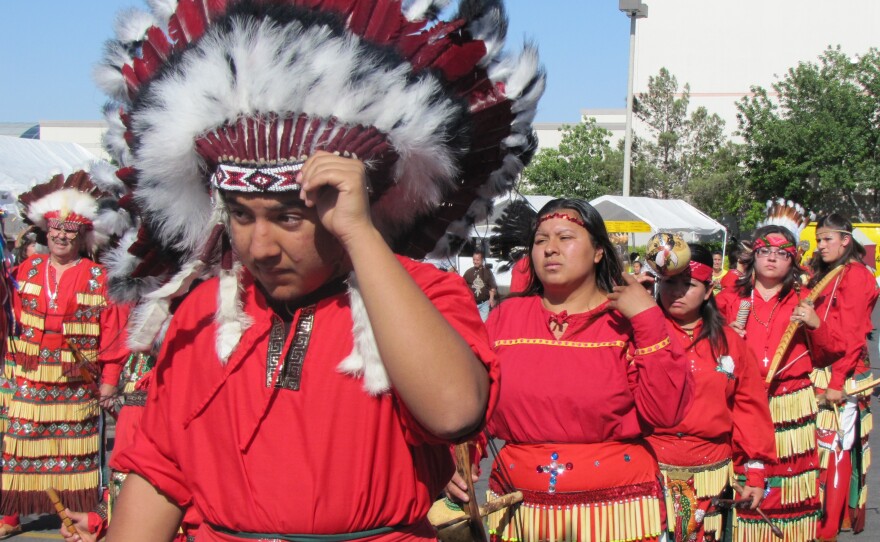Once a week, a crowd gathers outside of Martinez Elementary School in North Las Vegas. In the dimming light, on a patch of asphalt, a couple dozen dancers line up in two columns, facing four drummers. In their right hands they shake rattles made out of gourds, also called “guajes”.
The dancers crouch, shuffle and stomp to the beat in unison. Their sandaled feet slap the pavement; their faces are fierce with concentration. When the drums stop they let out a collective whoop.
The ritual is known as the Dance of the Matachines, and it dates back to the Spanish Conquest.
“There is a spirit that gets into you,” said Jesus Perez, who helped found the dance troupe with his family 20 years ago. “You feel it, and you get chills all the way up your back.”
Hundreds of years ago, Spanish clergy used the matachines dance to convert indigenous groups in the Americas to Catholicism and inspire devotion to the Virgin of Guadalupe.
"It is a dance of battle, of struggle, of exchange, of conversion, of transformation, in which people end up devotees or soldiers of the virgin,” said Sylvia Rodriguez, an anthropologist at the University of New Mexico, who studies matachines dancers in her state.
The dance has lived on as a mestizo custom in the northern Mexican border region and in the American southwest. In Las Vegas, it is the legacy of the Perez family, who brought the ritual with them from the border town of Ciudad Juárez, Mexico.
Perez and his seven siblings first began dancing as children in Ciudad Juárez in the 1960s. The dance connected them to their indigenous lineage that traces back to the Apache and Tarahumara tribes. The family eventually moved to Las Vegas so the parents could work in the casinos. Despite the distance, the Perez children returned to Mexico in the summers to dance.
“Over there it is very aggressive, it is kind of almost like a fight,” Perez remembered. “It would kind of scare me when we were little. I would run sometimes and cry.”
Perez still thinks of the dance as a war dance, but not in the traditional sense.
“Now it is more like a dance for life,” Perez said. “So that is what it is now: It’s a war to keep going, keep trying and to keep your culture going. And that is the fight we got right now.”
The Perez siblings created a Las Vegas dance troupe modeled on their old troupe in Mexico. They even named themselves “Matachines de Ciudad Juárez”.
The Matachines de Ciudad Juárez perform several times a year at religious events and street fairs around town. They wear feathered headdresses and handmade garments adorned with bamboo beads that rattle when they dance.
Krystal Reyes, a 20-year-old college student, saw the Perez family perform at a midnight mass in Las Vegas when she was a small child.
“I would always tell my mom, ‘Mom we want to be one of those, we want to be one of those,’” Reyes said. “And here we are.”
Reyes is now one of the lead dancers, called a “monarca”. When the troupe performed last month at a Cinco de Mayo fair, she danced in the center, twirling a wooden hunting bow. She hopes those performances of the matachines tradition will make Mexicans in Las Vegas feel proud.
“I hope it reminds them of what they are back at home, how they can be or how they can feel,” Reyes said after the Cinco de Mayo performance. “I mean, we are warriors, we fought, that is every one of us.”
In the past, the troupe would use the summer to prepare for a three-day festival in August celebrating “San Lorenzo” (St. Lawrence) in Ciudad Juárez. The festival draws hundreds of matachines dancers from all over northern Mexico.
But for the last three years, the Las Vegas dancers haven’t made the pilgrimage. The drug violence in Juárez has kept them away.
The separation from the Juárez dancers is hardest on Jesus’ oldest brother, Jose, who has the longest connection to the city.
“It’s a spiritual loss,” the elder Perez brother said in Spanish. “You aren’t with your people. Those are our people. We could say we are connected with the same sound of the drum.”
Their fear is that as time goes by, their version of the dance will become less authentic if they don’t compare their steps to other dancers. But in the meantime, the Las Vegas troupe will focus on local performances and the next generation.
“My favorite is showing the little kids to dance,” Jesus Perez said. “That is my favorite part.”
About a dozen kids between the ages of 2 and 10 are learning the steps, including Jesus Perez’s 7-year-old daughter. That makes her grandmother, Ofelia Perez — the matriarch of the troupe —very happy.
“Since they were born here, and since they don’t go to Mexico very often, it is important to teach them to not lose their heritage,” Ofelia Perez said in Spanish. “That they know where we came from and what we do.”
Jesus Perez is prepared to take the time to truly instill in his daughter an understanding of the matachines tradition.
“Being a matachines is forever,” he said. “You never stop learning until you’re dead.”






